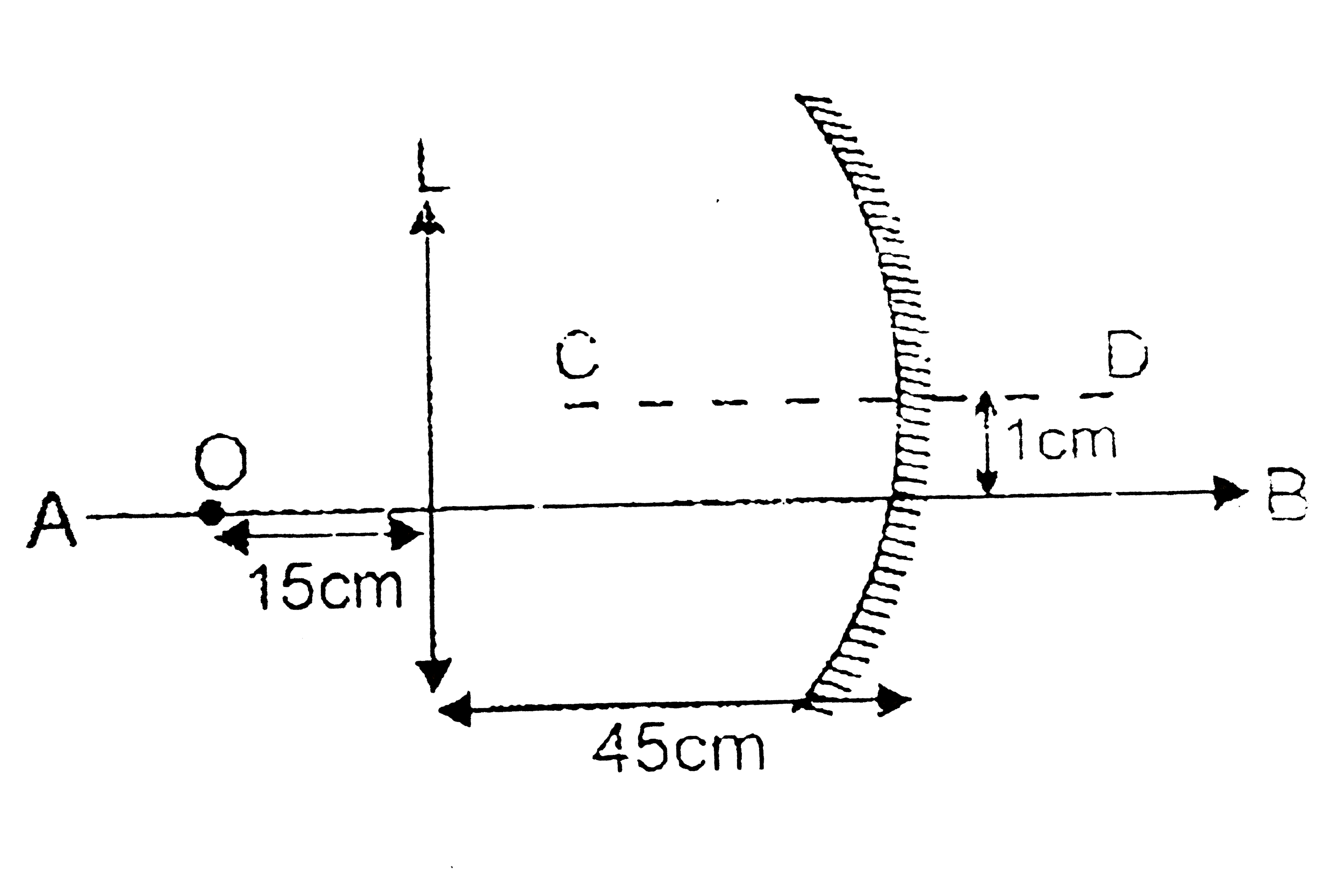_S01_030_Q01.png)
In the figure shown S is a point monochromatic light source of frequency 6×1014Hz.M is a concave mirror of radius of curvature 20 cm and L is a thin converging lens of focal length 3.75 cm AB is the principal axis of M and L.
Light reflected from the mirror and refracted from the lens in succession reaches the screen. An interference pattern is obtained on the screen by this arrangement.
Q. If the lens is replaced by another converging lens of focal length 103cm and the lens is shifted towards right by 2.5 cm then
fringe width remains same
intensity of pattern will remain same
fringe width will change
No interference pattern will form.
The correct Answer is:D
_S01_030_S01.png)
Image formed by the combination is I2 at
1v−1−5=310⇒v=10cm it will coincide with S
So no interference pattern on the screen.
Topper's Solved these Questions
- BOOK - ALLENCHAPTER - WAVE OPTICSEXERCISE - Example 131videos
WAVE OPTICS
- BOOK - ALLENCHAPTER - WAVE OPTICSEXERCISE - Example 141videos
WAVE OPTICS
- BOOK - ALLENCHAPTER - WAVE OPTICSEXERCISE - Example 111videos
WAVE OPTICS
- BOOK - ALLENCHAPTER - UNIT & DIMENSIONS, BASIC MATHS AND VECTOR EXERCISE - Exercise (J-A)7videos
UNIT & DIMENSIONS, BASIC MATHS AND VECTOR
Similar Questions
A converging lens of focal length 5 cm is placed at a distance of 20 cm from a screen. How far from the lens should an object be placed so as to form its real image on the screen?
View SolutionA luminous object is placed at a distance of 40 cm from a converging lens of focal length 25 cm. The image obtained in the screen is
View Solution
Knowledge Check
- Question 1 - Select One
_S01_029_Q01.png)
In the figure shown S is a point monochromatic light source of frequency 6×1014Hz.M is a concave mirror of radius of curvature 20 cm and L is a thin converging lens of focal length 3.75 cm AB is the principal axis of M and L.
Light reflected from the mirror and refracted from the lens in succession reaches the screen. An interference pattern is obtained on the screen by this arrangement.
Q. Fringe width isA1 mmB0.5 mmC1.5 mmD0.25 mm - Question 2 - Select One
_S01_028_Q01.png)
In the figure shown S is a point monochromatic light source of frequency 6×1014Hz.M is a concave mirror of radius of curvature 20 cm and L is a thin converging lens of focal length 3.75 cm AB is the principal axis of M and L.
Light reflected from the mirror and refracted from the lens in succession reaches the screen. An interference pattern is obtained on the screen by this arrangement.
Q. Distance between two coherent sources whichmakes interference pattern on the screen isA1 mmB0.5 mmC1.5 mmD0.25 mm - Question 3 - Select One
An illuminated object is placed at a distance of 20 cm from a converging lens of focal length 15 cm. The image obtained on the screen is:
Aupright and magnifiedBinverted and magnifiedCinverted and diminishedDupright and diminished.
In the figure shown L is a converging lens of foacl length 10cm and M is a concave mirror of radius of curvature 20cm. A point object O is placed in front of the lens at a distance 15cm.AB and CD are optical axes of the lens and mirror repectively. Find the distance of the final image formed by this system from the optical centre of the lens. The distance between CD&AB is 1cm
 View Solution
View SolutionA concave lens of focal length 20 cm is placed 15 cm in front of a concave mirror of radius of curvature 26 cm and further 10 cm away from the lens is placed an object. The principal axis of the lens and the mirror are coincident and the object is on the axis Find the position and nature of the image.
View SolutionAn illuminated object is placed at a distance of 20 cm from a converging lens of focal length 15 cm. The image obtained on the screen is:
View SolutionIn the figure shown L is converging lens of focal length 10 cm and M is a concave mirror of radius of curvature 20 cm . A point object O is placed in front of the lens at a distance 15 cm . AB and CD are optical axes of the lens mirror respectively. Find the coordinates of the final image formed by this system taking O as origin. The distance between CD & AB is 1mm.
_E01_138_Q01.png) View Solution
View SolutionA point source of light is being moved closer to a thin concave lens from a large distance on its principal axis. Is the radius of curvature of the refracted wave front, close to the lens, increasing or decreasing?
View Solution

